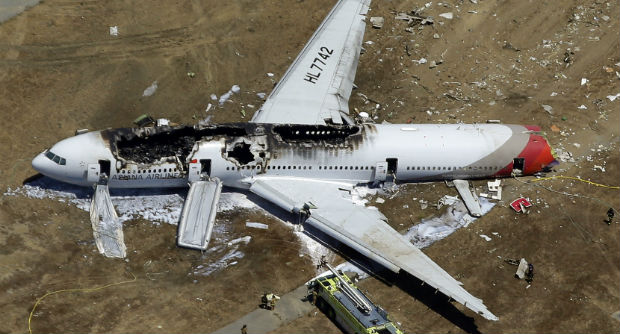
In this July 6, 2013 aerial file photo, the wreckage of Asiana Flight 214 lies on the ground after it crashed at the San Francisco International Airport in San Francisco. Nearly a year after Asiana Flight 214 crashed while landing in San Francisco, the National Transportation Safety Board is meeting to determine what went wrong, who’s to blame and how to prevent future accidents. AP
WASHINGTON — Asiana Flight 214’s pilots caused the crash last year of their airliner carrying more than 300 people by bungling a landing approach in San Francisco, including inadvertently deactivating the plane’s key control for airspeed, the U.S. National Transportation Safety Board concluded Tuesday.
But the board also said the complexity of the Boeing 777’s autothrottle and auto flight director — two of the plane’s key systems for controlling flight — contributed to the accident. Materials provided to airlines by Boeing that fail to make clear under what conditions the autothrottle doesn’t automatically maintain speed were also faulted.
The 777 has been in service 18 years and is one of the world’s most popular wide-bodied airliners, especially for international travel. Until last year’s accident, it had not been involved in a single fatal crash.
The board’s acting chairman, Chris Hart, warned that the accident underscores a problem that has long troubled aviation regulators around the globe — that increasingly complicated automated aircraft controls designed to improve safety are also creating new opportunities for error.
The Asiana flight crew “over-relied on automated systems that they did not fully understand,” Hart said.
“In their efforts to compensate for the unreliability of human performance, the designers of automated control systems have unwittingly created opportunities for new error types that can be even more serious than those they were seeking to avoid,” he said.
The South Korea-based airline’s pilot training also was faulted.
Of the 307 people on board Flight 214, three Chinese teens were killed in the July 6, 2013 crash. Nearly 200 were injured, including 49 seriously. It remains the only fatal passenger airline crash in the U.S. in the past five years.
Asiana Airlines said it has already implemented the NTSB’s training recommendations, and that it agreed with the NTSB’s finding that one factor was the complexity of the autothrottle and autopilot systems, as well as their descriptions in Boeing training manuals.
Boeing immediately rejected the notion that the 777’s automated systems contributed to the accident, pointing to the aircraft’s safety record.
“The auto-flight system has been used successfully for over 200 million flight hours across several airplane models, and for more than 55 million safe landings,” the company said in a statement. “The evidence collected during this investigation demonstrates that all of the airplane’s systems performed as designed.”
The board, which made 27 recommendations to prevent future disasters, didn’t say that the autothrottle failed to perform as designed. But rather that its design, under certain circumstances, could lead to confusion as to whether it was controlling speed or in an inactive state.
The safety board “did the right thing,” said Ilyas Akbari, a Los Angeles attorney representing 16 of Flight 214’s passengers. “It took courage to call out Boeing because it’s an American manufacturer” and one of the nation’s largest employers and exporters.
But most of the fault lies with Asiana and its pilots, Akbari said.
Investigators said the flight’s three veteran pilots made 20 to 30 different errors, some minor and others significant, during the landing approach on July 6, 2013.
Among the errors were that pilots didn’t follow company procedures when they failed to call out notifications about the plane’s altitude, speed and actions they were taking during the landing approach. They also weren’t closely monitoring the plane’s airspeed — a fundamental of flying. Instead, they assumed the autothrottle was maintaining the required speed for a safe landing.
But the captain flying the plane, Lee Kang Kuk, 45, who was new to the 777, inadvertently prevented the autothrottle from controlling the plane’s speed. Kuk put the throttle in idle after the plane had unexpectedly climbed too high. He assumed the throttle would automatically resume controlling speed, as it is designed to do under most circumstances. But because he turned off the autopilot at the same time, the autothrottle remained on hold in at the last selected speed, which was idle.
A training captain who was sitting next to Kuk in the right seat didn’t notice the error, and then compounded it by turning off only one of two other key systems for managing the flight. Both systems are supposed to be on or off, but not one on and one off.
A third pilot riding in the jump seat noticed the plane was descending too fast but didn’t speak up right away. The pilots also didn’t immediately start to abort the landing when they realized something had gone awry. But by the time they did call for a “go-around” it was too late.
The plane was too low and too slow as it neared the runway. Its tail struck a seawall and was ripped off. The rest of plane went spinning and sliding down the runway.
The two of three teens who were killed weren’t wearing their seatbelts and were thrown from the plane. The third teen was hit on the head by one of the plane’s doors but survived the crash. She was killed when, lying unconscious, she was run over by two San Francisco Fire Department vehicles in the chaos afterward. Nearly 200 people were injured.
RELATED STORIES
Jet partly to blame in California crash–Asiana
PH aviation officials await US probe on Asiana Airlines crash in San Francisco
Asiana pilot asked to abort landing before fatal crash